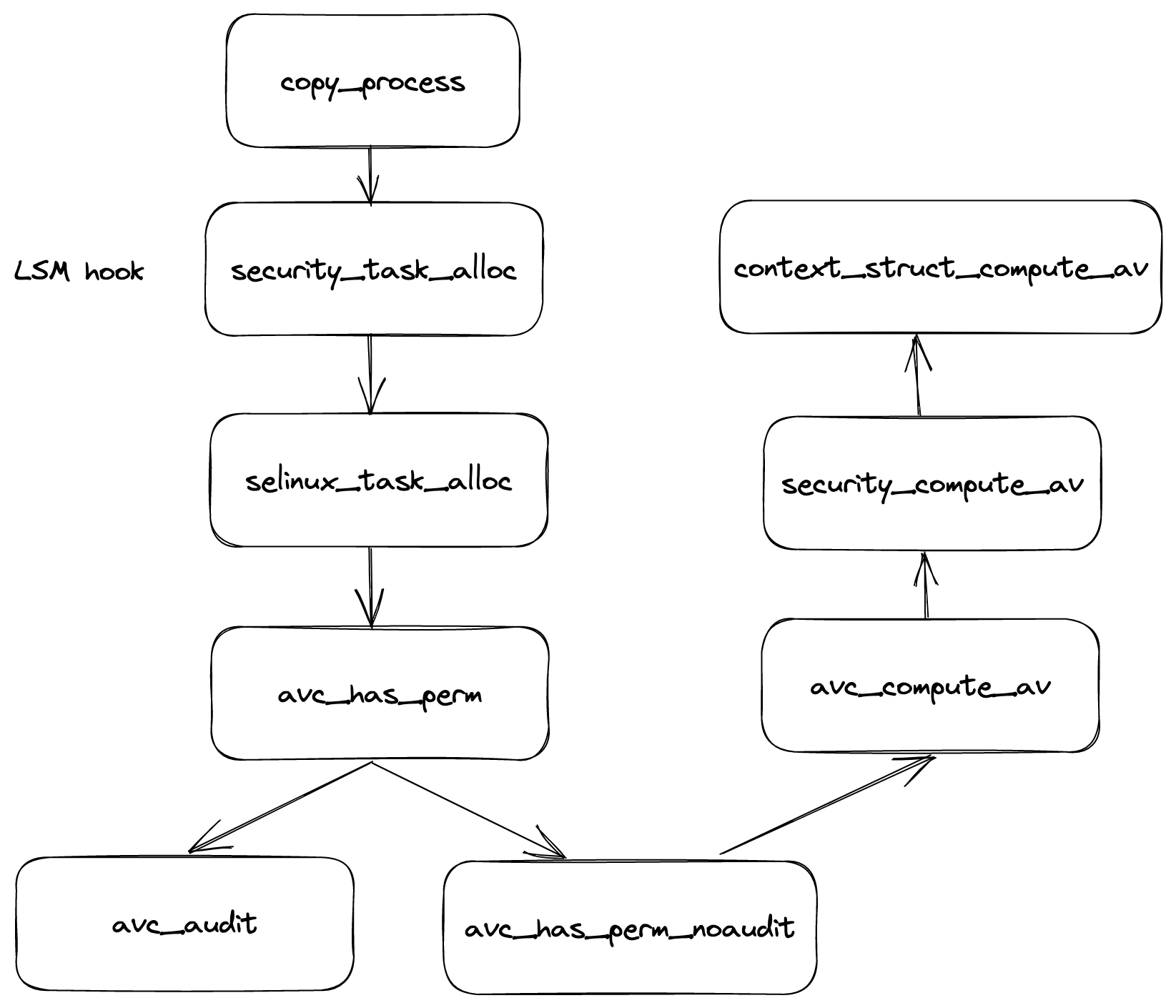为了更加熟悉SELinux,针对这个安全机制的源码部分做了一些梳理,结合了官方的指南丰富了其中的源码实现细节。SELinux博大精深,这篇讲述该机制的内核部分实现,包括贯穿整个机制的两个核心——对系统行为的检查以及标签的转换,以及比较核心的数据和接口。
备注:我的源码分析中忽略了mls机制,在一些检查点中针对mls有额外的处理。
核心流程一:对系统调用行为的鉴权 我这里拿fork系统调用为例子🌰,整个调用过程核心流程如下图所示:
首先是系统调用的入口函数里会存在一些hook点,比如这里的fork系统调用在copy_process中存在security_task_alloc,而这个是LSM的hook点位。SELinux的hooks.c中selinux_hooks结构体数组将SELinux相关的检查函数用LSM_HOOK_INIT设置到对应的hook点上。
在某个进程触发fork系统调用,到达安全检测点会跳转到selinux_task_alloc函数。该函数则是SELinux检测这个系统调用是否有权限执行。不同的系统调用有不同的检查逻辑,最终会调用的权限检查函数也有所不同,fork系统调用的检查函数是avc_has_perm。
avc_has_perm函数在avc.c中,用于检查系统调用是否被授权。其中有两个主要函数分别为avc_has_perm_noaudit和avc_audit,avc_has_perm_noaudit主要做具体的权限检查,而avc_audit则是记录avc日志信息。
avc_has_perm_noaudit首先给自己加上rcu的读锁,然后从已有的avc数据中查找是否缓存过,找得到就直接复制一份出来,没有找到则进入avc_compute_av计算av数据。根据av数据中的规则权限和请求的权限求得这次请求是否被允许,如果行为不允许,会进入avc_denied将这次的av结果更新。
avc_compute_av主要包含两个函数,其一是 security_compute_av,负责计算av数据;其二是avc_insert将计算到的avc数据插入缓存中。security_compute_av通过ssid和tsid在sidtab中搜索到scontext和tcontext进入到整个流程的核心函数context_struct_compute_av。
context_struct_compute_av函数含有多个检查访问是否合法的步骤。
avd内容的初始化;
遍历检查对象类和权限,并根据节点的类型(AVTAB_ALLOWED、AVTAB_AUDITALLOW、AVTAB_AUDITDENY、AVTAB_XPERMS)将数据整合进avd中;
cond_compute_av检查是否有条件语句规则包含在这次的访问判断中,如果存在则会对权限做修改;通过constraint_expr_eval查看是否存在额外约束,根据额外约束移除权限;
如果进程标签转换正在执行,需要检测是否有transition或dyntransition权限,是否有角色的改变。
检查是否有typebounds规则约束应用在这次访问中,根据额外约束修正权限
这些结果都保存在avd数据中
avc_audit会先利用avc_audit_required检查是否要记录audit日志,再调用slow_avc_audit函数构造具体的日志信息。avc_audit_required内部会先把请求的权限和取反后的允许权限做与操作,这样就能得到是否拒绝该行为。但这里会有另外一个位avd->auditdeny,如果该位被置为0,则这个拒绝行为不会被记录在audit日志中。
当整个鉴权过程结束之后会从selinux_task_alloc返回,一路返回到fork自身的copy_process中继续系统调用执行。
核心流程二:进程的标签转换 SELinux中存在一种规则type_transition,让一个带着标签的进程,执行另外一个带着标签的文件时,发生标签转换,从原有的标签转换成其他设置的标签。
type_transition unconfined_t secure_services_exec_t : process ext_gateway_t;
unconfined_t的进程执行了带着secure_services_exec_t的文件,触发标签转换,该文件执行成功变成进程后为ext_gateway_t。但要真正的执行转换还需要有三个权限:
(1)allow unconfined_t ext_gateway_t : process transition;标签间的转换权限
(2)allow unconfined_t secure_services_exec_t : file { execute read getattr };进程执行文件的权限
(3)allow ext_gateway_t secure_services_exec_t : file entrypoint;转换标签必须有进入点权限
因为是要拉起另外一个进程所以入口都是在do_execveat_common中。
整个过程分为三个阶段
第一个阶段是检查进程标签转换的标签内容
首先从程序执行入口处进入alloc_bprm,这里会分配linux_binprm结构体,这个结构体记录了二进制执行程序的相关信息,包括核心的凭证和权限,参数,环境变量,文件名等内容。经过一系列的字符串拷贝和参数检查,进入到bprm_execve执行新的二进制程序。bprm_execve函数中有LSM的hook点位security_bprm_creds_for_exec,最终调用selinux_bprm_creds_for_exec。
selinux_bprm_creds_for_exec会调用security_transition_sid检查程序的标签转换内容,而这个函数只是security_compute_sid的一层封装,security_compute_sid中会确认是否需要计算新的sid。大概分成下面的流程:
搜索sidtab中的ssid和tsid,获得scontext和tcontext;
设置用户id、角色id和标签类型;
检查是否有type_transition规则在av数据中或者条件av数据中
如果存在标签转换,检查是否有role_transition角色转换,并设置好角色
检查新的标签内容是否合法,不合法内容将会被日志记录;
调用sidtab_context_to_sid获得新标签的sid,并在sidtab中更新
第二个阶段检查进程是否有转换等权限
从selinux_bprm_creds_for_exec中执行完security_transition_sid后,会有许多的avc_has_perm函数用来确认是否有相关的转换权限。首先会检查,是否有execute_no_trans权限,拥有该权限会直接返回,没有则继续检查transition、entrypoint等其他权限。
第三个阶段检查执行二进制的相关权限
在前面两个阶段的检查结束后,会返回到bprm_execve中继续执行到exec_binprm,这个函数会调用search_binary_handler寻找二进制文件相应的处理器,并在处理其中执行它的.load_binary函数指针执行到load_xxx_binary中,这些函数最后的入口点在begin_new_exec。
begin_new_exec会在最后执行security_bprm_committing_creds和security_bprm_committed_creds这两个hook点对应,selinux_bprm_committing_creds和selinux_bprm_committed_creds。第一个函数用于进程初始化凭证,这里会检查是否有权限限制,第二个函数针对不会继承信号状态的进程做信号清除。
核心数据和接口 SELinux状态信息的全局变量 struct selinux_state selinux_state;
1 2 3 4 5 6 7 8 9 10 11 12 13 14 15 16 17 18 struct selinux_state {#ifdef CONFIG_SECURITY_SELINUX_DISABLE bool disabled; #endif #ifdef CONFIG_SECURITY_SELINUX_DEVELOP bool enforcing; #endif bool checkreqprot; bool initialized; bool policycap[__POLICYDB_CAP_MAX]; struct page *status_page ; struct mutex status_lock ; struct selinux_avc *avc ; struct selinux_policy __rcu *policy ; struct mutex policy_mutex ; } __randomize_layout;
一个记录SELinux的全局状态的结构体,里面包括了SELinux的开启状态,是否为enforcing模式,是否初始化,规则指针,avc记录缓存指针等信息。
hooks挂载函数表 hooks挂载都在hooks.c文件中,把SELinux的检查函数挂载在不同系统调用的安全函数hook点中。
static struct security_hook_list selinux_hooks[] __lsm_ro_after_init
1 2 3 4 5 6 ... LSM_HOOK_INIT(inode_create, selinux_inode_create), LSM_HOOK_INIT(inode_link, selinux_inode_link), LSM_HOOK_INIT(inode_unlink, selinux_inode_unlink), LSM_HOOK_INIT(inode_symlink, selinux_inode_symlink), ...
av数据管理 管理av数据的相关结构体
1 2 3 4 5 6 7 8 9 10 11 12 13 14 15 16 17 18 19 20 21 22 23 24 25 26 27 28 29 30 31 32 33 34 struct selinux_avc { unsigned int avc_cache_threshold; struct avc_cache avc_cache ; }; struct avc_cache { struct hlist_head slots [AVC_CACHE_SLOTS ]; spinlock_t slots_lock[AVC_CACHE_SLOTS]; atomic_t lru_hint; atomic_t active_nodes; u32 latest_notif; }; struct avc_node { struct avc_entry ae ; struct hlist_node list ; struct rcu_head rhead ; }; struct avc_entry { u32 ssid; u32 tsid; u16 tclass; struct av_decision avd ; struct avc_xperms_node *xp_node ; }; struct av_decision { u32 allowed; u32 auditallow; u32 auditdeny; u32 seqno; u32 flags; };
selinux_avc->avc_cache.slots是挂着avc_node的list。而avc_code的ae管理着基本的请求源和目标对象的id值,通过这两个id能找到对应的标签,avd则是记录请求的权限。
策略数据管理 1 2 3 4 5 6 7 8 9 10 11 12 13 14 15 16 17 18 19 20 21 22 23 24 25 26 27 28 29 30 31 32 33 34 35 36 37 38 39 40 41 42 43 44 45 46 47 48 49 50 51 52 53 54 55 56 57 58 59 60 61 62 63 64 65 66 67 68 69 70 71 72 73 74 75 76 77 78 79 struct policydb { int mls_enabled; struct symtab symtab [SYM_NUM ]; #define p_commons symtab[SYM_COMMONS] #define p_classes symtab[SYM_CLASSES] #define p_roles symtab[SYM_ROLES] #define p_types symtab[SYM_TYPES] #define p_users symtab[SYM_USERS] #define p_bools symtab[SYM_BOOLS] #define p_levels symtab[SYM_LEVELS] #define p_cats symtab[SYM_CATS] char **sym_val_to_name[SYM_NUM]; struct class_datum **class_val_to_struct ; struct role_datum **role_val_to_struct ; struct user_datum **user_val_to_struct ; struct type_datum **type_val_to_struct ; struct avtab te_avtab ; struct hashtab role_tr ; struct ebitmap filename_trans_ttypes ; struct hashtab filename_trans ; u32 compat_filename_trans_count; struct cond_bool_datum **bool_val_to_struct ; struct avtab te_cond_avtab ; struct cond_node *cond_list ; u32 cond_list_len; struct role_allow *role_allow ; struct ocontext *ocontexts [OCON_NUM ]; struct genfs *genfs ; struct hashtab range_tr ; struct ebitmap *type_attr_map_array ; struct ebitmap policycaps ; struct ebitmap permissive_map ; size_t len; unsigned int policyvers; unsigned int reject_unknown : 1 ; unsigned int allow_unknown : 1 ; u16 process_class; u32 process_trans_perms; } __randomize_layout;
比较关键的成员是两个avtab,里面记录了av相关的数据内容,用于计算访问权限。
selinuxfs对外接口 SELinux文件系统的文件接口,用户态通过这些接口与内核功能交互。
1 2 3 4 5 6 7 8 9 10 11 12 13 14 15 16 17 18 19 20 21 22 static const struct tree_descr selinux_files [] = { [SEL_LOAD] = {"load" , &sel_load_ops, S_IRUSR|S_IWUSR}, [SEL_ENFORCE] = {"enforce" , &sel_enforce_ops, S_IRUGO|S_IWUSR}, [SEL_CONTEXT] = {"context" , &transaction_ops, S_IRUGO|S_IWUGO}, [SEL_ACCESS] = {"access" , &transaction_ops, S_IRUGO|S_IWUGO}, [SEL_CREATE] = {"create" , &transaction_ops, S_IRUGO|S_IWUGO}, [SEL_RELABEL] = {"relabel" , &transaction_ops, S_IRUGO|S_IWUGO}, [SEL_USER] = {"user" , &transaction_ops, S_IRUGO|S_IWUGO}, [SEL_POLICYVERS] = {"policyvers" , &sel_policyvers_ops, S_IRUGO}, [SEL_COMMIT_BOOLS] = {"commit_pending_bools" , &sel_commit_bools_ops, S_IWUSR}, [SEL_MLS] = {"mls" , &sel_mls_ops, S_IRUGO}, [SEL_DISABLE] = {"disable" , &sel_disable_ops, S_IWUSR}, [SEL_MEMBER] = {"member" , &transaction_ops, S_IRUGO|S_IWUGO}, [SEL_CHECKREQPROT] = {"checkreqprot" , &sel_checkreqprot_ops, S_IRUGO|S_IWUSR}, [SEL_REJECT_UNKNOWN] = {"reject_unknown" , &sel_handle_unknown_ops, S_IRUGO}, [SEL_DENY_UNKNOWN] = {"deny_unknown" , &sel_handle_unknown_ops, S_IRUGO}, [SEL_STATUS] = {"status" , &sel_handle_status_ops, S_IRUGO}, [SEL_POLICY] = {"policy" , &sel_policy_ops, S_IRUGO}, [SEL_VALIDATE_TRANS] = {"validatetrans" , &sel_transition_ops, S_IWUGO}, {"" } };
sidtab结构 记录标签内容和对应sid值,在鉴权过程中可以只通过sid值找到标签。
1 2 3 4 5 6 7 8 9 10 11 12 13 14 15 16 17 18 19 20 21 22 23 24 25 26 27 28 29 30 31 32 33 34 35 36 37 38 39 40 41 42 43 44 45 46 47 48 49 50 51 52 53 54 55 56 57 58 59 60 61 62 struct sidtab_entry { u32 sid; u32 hash; struct context context ; #if CONFIG_SECURITY_SELINUX_SID2STR_CACHE_SIZE > 0 struct sidtab_str_cache __rcu *cache ; #endif struct hlist_node list ; }; union sidtab_entry_inner { struct sidtab_node_inner *ptr_inner ; struct sidtab_node_leaf *ptr_leaf ; }; struct sidtab_node_leaf { struct sidtab_entry entries [SIDTAB_LEAF_ENTRIES ]; }; struct sidtab_node_inner { union sidtab_entry_inner entries[SIDTAB_INNER_ENTRIES]; }; struct sidtab_isid_entry { int set ; struct sidtab_entry entry ; }; struct sidtab_convert_params { struct convert_context_args *args ; struct sidtab *target ; }; struct sidtab { union sidtab_entry_inner roots[SIDTAB_MAX_LEVEL + 1 ]; u32 count; struct sidtab_convert_params *convert ; bool frozen; spinlock_t lock; #if CONFIG_SECURITY_SELINUX_SID2STR_CACHE_SIZE > 0 u32 cache_free_slots; struct list_head cache_lru_list ; spinlock_t cache_lock; #endif struct sidtab_isid_entry isids [SECINITSID_NUM ]; DECLARE_HASHTABLE(context_to_sid, SIDTAB_HASH_BITS); };

